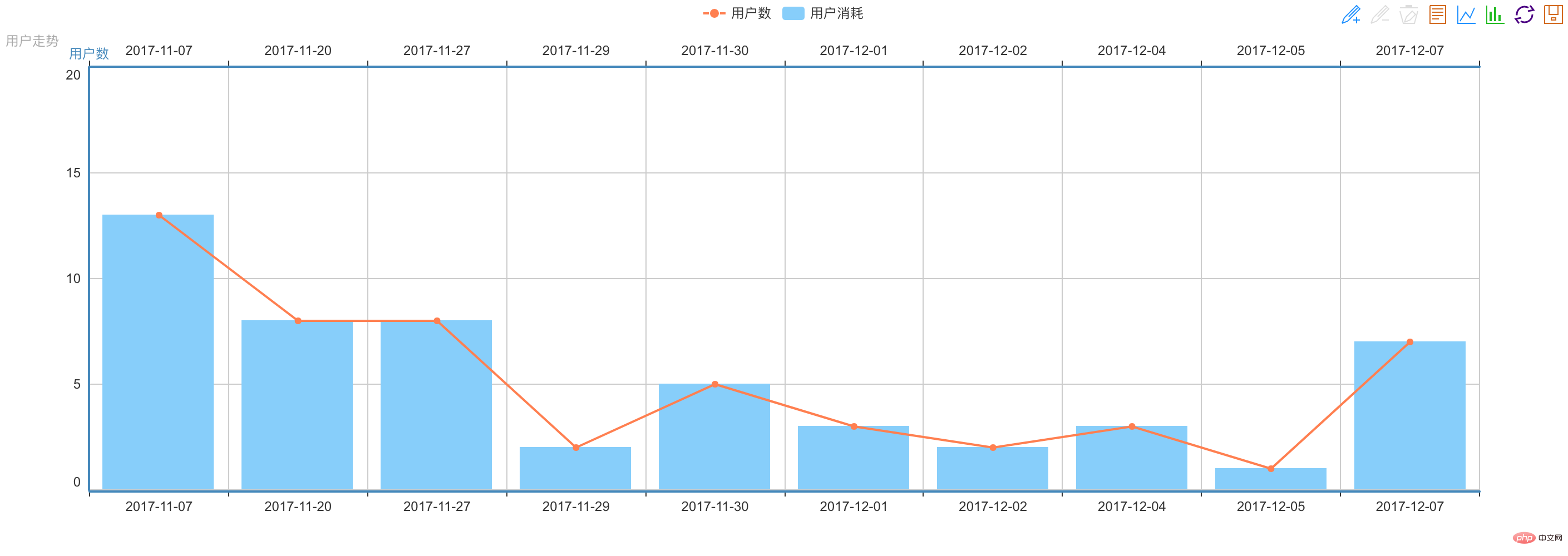Home >Backend Development >PHP Tutorial >How to use Echarts to generate statistical reports in PHP
How to use Echarts to generate statistical reports in PHP
- 藏色散人forward
- 2020-09-28 17:00:096887browse
echarts statistics, simple example
Recommended: "PHP Video Tutorial"
Look at the renderings first

Look at the code
HTML page Prepare a Dom for ECharts, customize the width and height
<div class="panel panel-info"> <div class="panel-body"> <div id="echart_show" style="height:500px"></div> </div> </div>
js file can refer to the official website, or download it here and introduce
<script type="text/javascript" src="__ROOT__/Public/admin/lib/jquery/nowdatachars/echarts-all.js"></script>
The following is the specific method
<script type="text/javascript">
var date = [],num = [];
$(document).ready(function () {
// 绘制反馈量图形
var init_echarts = function () {
var refreshChart = function (show_data) {
my_demo_chart = echarts.init(document.getElementById('echart_show'));
my_demo_chart.showLoading({
text: '加载中...',
effect: 'whirling'
});
var echarts_all_option = {
title: {
text: '',
subtext: '用户走势'
},
tooltip: {
trigger: 'axis'
},
legend: {
data: ['用户数', '用户消耗']
},
toolbox: {
show: true,
feature: {
mark: {show: true},
dataView: {show: true, readOnly: false},
magicType: {show: true, type: ['line', 'bar']},
restore: {show: true},
saveAsImage: {show: true}
// myTool2: {
// show: true,
// title: '自定义扩展方法',
// icon: 'image://http://echarts.baidu.com/images/favicon.png',
// onclick: function (){
// alert('自定义')
// }
// }
}
},
dataZoom: {
show: false,
start: 0,
end: 100
},
xAxis: [
{
type: 'category',
boundaryGap: true,
data: show_data[1]
},
{
type: 'category',
boundaryGap: true,
data: show_data[1]
}
],
yAxis: [
{
type: 'value',
scale: true,
name: '用户数',
boundaryGap: [0, 0.5]
// boundaryGap: [0.2, 0.2]
},
{
type: 'value',
scale: true,
name: '用户数',
boundaryGap: [0, 0.5]
}
],
series: [
{
name: '用户消耗',
type: 'bar',
xAxisIndex: 1,
data: show_data[0]
},
{
name: '用户数',
type: 'line',
xAxisIndex: 1,
data:show_data[0]
}
]
};
my_demo_chart.hideLoading();
my_demo_chart.setOption(echarts_all_option);
};
// 获取原始数据
$.ajax({
url:"__CONTROLLER__/getRes",
async:false,
dataType:'json',
type:'post',
success:function(msg){
var result = msg.result;
if(msg.code == 200){
for(var i = 0 ; i < result.length; i++){
date.push(result[i].date);
num.push(result[i].count);
msg[0] = num;
msg[1] = date;
refreshChart(msg);
}
}
}
});
};
// 默认加载
var default_load = (function () {
init_echarts();
})();
});
</script>Query the data you need in the controller (the date queried here and the corresponding quantity)
//折线统计
public function getRes(){
$user = M('account');
$sql = "SELECT date(createTime) AS date,count(*) as count FROM t_account GROUP BY date ";
$result = $user->query($sql);
$this->ajaxReturn(array('code'=>200,'result'=>$result));
}At this point, a simple echarts statistical chart comes out
If you don’t understand some parameters in echarts, you can refer to the official website https://www.echartsjs.com/option.html#title
The above is the detailed content of How to use Echarts to generate statistical reports in PHP. For more information, please follow other related articles on the PHP Chinese website!

